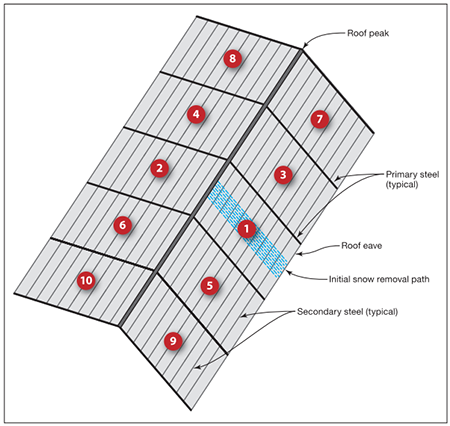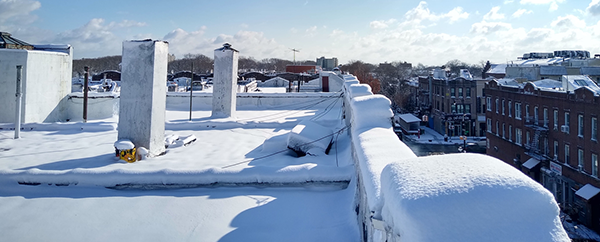Snow loads and ice dams: How to prepare for and prevent winter property damage
Depending on where you’re located, winter can wreak all kinds of property damage, from pavement upheaval, power loss and frozen pipes, to roof collapse and water intrusion. That’s why it’s critical to take steps to prepare for and prevent winter property damage.
Snow accumulation in excess of building design conditions can result in structural failure and possible collapse if basic preventative steps are not taken in advance of a major snow. Snow-related roof failures are common occurrences every year, resulting in hundreds of millions of dollars in losses to businesses.
How do snow loads cause winter property damage?
Structural failure due to roof snow loads may be linked to several possible causes such as
- Actual snow load significantly exceeds the snow load the roof was designed to handle
- Age of building and older building codes
- Sloped warm roofs causing refreezing on cold eaves, leading to ice dams or backup of ice under shingles
- Barrel-vault and saw-toothed roofs collecting excess snow and ice in valleys
- Rain on top of heavy snowfall, significantly increasing the weight on roofs
- Not continually heating a structure, causing melting/refreezing/and subsequent ice build-up
- Drifting and sliding snow conditions caused by wind
- Improper design or deficient workmanship
- Inadequate drainage design
- Insufficient operation and maintenance
Does snow really weigh that much?
The weight of 1 foot of fresh snow ranges from 3 pounds per square foot for light, dry snow to 21 pounds per square foot for wet, heavy snow. Just one inch of ice weighs a little less than 5 pounds per square foot. One foot of ice weighs approximately 57 pounds per square foot. Ice weighs significantly more than heavy, wet snow per inch depth. That’s why it’s important to prevent both snow and ice buildup on roof structures.
Snow in the western United States is typically lighter and less dense than snow on the East Coast, which tends to be wetter and denser. There are exceptions based on locality and unique weather conditions, such as the Pacific Northwest around Seattle and the southwestern coast of Alaska.
Related: The hard, cold facts on how to prevent winter damage
Know the hazards so you can prevent winter property damage
Unbalanced snow loading is when snow accumulates at different depths in different locations on a roof, resulting in differential snow load. Unbalanced snow load poses a greater risk to the roof structural system than a uniform snow load, often caused by drifting or sliding snow. Certain types of roofs (barrel or saw-tooth) are more susceptible, as snow accumulates in pockets.
Drifting snow results when the wind moves snow from one portion of the roof to another. Snow drifts often form on a lower roof in the wind shadow of the higher portions of the building. Snow can also be blown up against and accumulate next to an obstruction (e.g., high roof framing, rooftop equipment, parapet, adjacent building, dormer windows). The snow depth at this obstruction is greater than the overall roof snow depth, creating a larger load on the roof structure at the location of the drift.
Sliding snow can occur when a sloped roof has no snow guard or cleats. Snow from a higher roof becomes unstable and slides onto a lower roof where it accumulates. This often occurs on porch/sunroom roofs and entrance canopies beneath gabled roofs of residential buildings. Snow depth on the lower roof where the snow slid is now greater than the overall roof snow depth, creating a larger load in these areas. The sudden, forceful action of the snow slide onto the lower roof may produce a significant impact on the lower roof framing, which can potentially overload the roof structure.
Ice dams. For gabled and sloped roof systems, uninsulated heated attics increase the likelihood for snow to melt or slide, potentially causing ice dams at roof eaves. Melting snow or ice flows down the roof slope and refreezes at the eave. As the ice dam becomes bigger, there’s more melt water blockage at the eave. Ice dams prevent snow from sliding off the roof, creating an unbalanced snow loading condition. A second (and potentially larger) problem that may arise from ice dams is water infiltration into the building interior.
Related: Prepare your home for winter – Easy tips!
Prevent winter property damage by inspecting these items prior to a major snow
Although the entire roof structure and building should be inspected, closer inspection is warranted at roof valleys, low points of saw-tooth roofs, abrupt roof elevation changes, parapets and other obstructions or protrusions that accumulate greater amounts of snow. Check roof framing for deterioration, weakness or modification. Look for leaks, sags and/or misalignment; corroded, cracked and/or buckled steel members; split and/or rotted timber; and cracked and/or spalled concrete members.
Dead loads, such as air conditioners, heaters and suspended storage platforms, will decrease the roof’s live load capacity when added to the roof’s structural members.
FEMA recommends inspecting to ensure
- Roofs are not ponding. Repair any low areas or add drains as needed.
- Gutters and downspouts are in good repair and debris-free.
- Seals around rooftop penetrations are intact.
- Openings around exhaust vents are sealed.
- Internally drained roof downspouts are clear of debris.
- Flashing around connections of rooftop equipment is intact.
- Roof soffit and ridge ventilation are free.
- If the roof has been retrofitted with additional insulation for energy conservation reasons, watch for additional dead loads due to reduced melting.
- If solar panels, mechanical equipment or other roof projections have been added, ensure the roof is able to bear additional sliding and driving snow loads.
- Cold eave electric heaters are properly functioning.
- Vertical position of trusses are not leaning out-of-plane.
- Metal plates connecting truss member chords are intact.
- Lateral braces are firmly connected to roof structure and do not show signs of over-stress or disrepair.
- Attic areas are dry and free of excess moisture.
Watch for these FEMA warning signs of overstress during a snowstorm:
- Sagging ceiling tiles or boards, ceiling boards falling out of the ceiling grid, and/or sagging sprinkler lines and sprinkler heads
- Sprinkler heads deflecting below suspended ceilings
- Popping, cracking, and creaking noises
- Sagging roof members, including metal decking or plywood sheathing
- Bowing truss bottom chords or web members
- Doors and/or windows that can no longer be opened or closed
- Cracked or split wood members
- Cracks in walls or masonry
After a major snow
Even if snow accumulation during a major snow does not surpass the threshold of building safety, removal of snow from the roof may still be recommended, in order to prevent winter property damage. Roof snow exposed to sunlight can soften, become denser, and then harden when the temperature drops below freezing, creating a concentrated area of loading on the roof.
If subsequent snow events are anticipated, removing snow from the roof will minimize the risk of accumulating snow causing structural damage. One benefit of immediate snow removal is that the effort required to remove the snow from the rooftop is reduced. However, when snow accumulation is minor, the likelihood of damaging the roofing material or risk of being on a roof outweighs the benefits of removal.
Snow removal safety measures
Remove snow safely, following proper OSHA protocol for work on rooftops.
- Use roof fall arrest harnesses where applicable.
- Always have someone below the roof to keep foot traffic away from locations where falling snow or ice could cause injuries.
- Confirm that the area below removal site is free of equipment that could be damaged by falling snow or ice.
- Whenever snow is being removed from a roof, be careful of dislodged icicles. An icicle falling from a short height can still cause damage or injury.
- When using a non-metallic snow rake, be aware that roof snow can slide at any moment. Keep a safe distance away from the eave to remain outside of the sliding range.
- Buried skylights pose a high risk to workers on a roof removing snow. Properly mark this hazard as well as other rooftop hazards prior to snow events.
Related: Winterize your vehicle fleet to minimize claims in deep freeze months
How to remove snow
Removing snow completely from a roof surface can result in serious damage to the roof covering and possibly lead to leaks and additional damage, says FEMA. Leave at least 2 inches of snow on the roof.
- Don’t use mechanical snow removal equipment. The risk of damaging the roof membrane or other rooftop items outweighs the advantage of speed.

Safe snow removal diagram by FEMA - Don’t use sharp tools, such as picks, to remove snow. Use plastic rather than metal shovels.
- Use a non-metallic snow rake for steep roof slopes if possible. Metal snow rakes can damage roofing material and should be avoided. Snow removal can be conducted from the ground, removing the risk to people on a hazardous roof.
- Remove drifted snow first at building elevation changes, parapets and around equipment.
- Once drifted snow has been removed, start remaining snow removal from the center portion of the roof.
- Remove snow in the direction of primary structural members (see image at right). This will prevent unbalanced snow loading.
- Do not stockpile snow on the roof.
- Dispose of removed snow in designated areas on the ground.
- Keep snow away from building exits, fire escapes, drain downspouts, ventilation openings and equipment.
- If possible, remove snow starting at the ridge and moving toward eaves for gable and sloped roofs.
- Upon completion of snow removal, the roofing material should be inspected for any signs of damage. Additionally, a quick inspection of the structural system may be prudent after particularly large snow events.
This article originally appeared on Arrowhead General Insurance Agency’s blog. It is used with permission and has been updated to better fit the needs of ACM’s customers.

